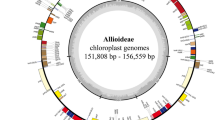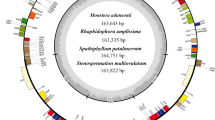Abstract
Chloroplast sequences spanning rps7 to 23S rDNA in Arceuthobium campylopodum and A. pendens were generated and compared to Arabidopsis and seven other parasitic plants. Pseudogenes for trnV, trnI (GAU), and trnA (UGC) were seen in both Arceuthobium species, paralleling the situation in the holoparasite Epifagus (Orobanchaceae). These tRNA genes were intact, however, in two other members of Santalales (Ximenia and Phoradendron). The 16S–23S rDNA intergenic spacer was sequenced for 13 additional species of Arceuthobium representing both Old and New World taxa. All species examined had pseudogenes for trnI and trnA, however, deletions in these tRNAs have occurred in different regions among various lineages of the genus. The aligned 16S–23S rDNA intergenic spacer was analyzed using maximum parsimony and compared with nuclear ITS rDNA using a similar suite of species. Overall species relationships were generally congruent, although two cases of potential lineage sorting or chloroplast capture were detected. Arceuthobium is a valuable genetic model to constrast with holoparasites because, despite significant alteration and truncation of its plastome, it still maintains photosynthetic function.




Similar content being viewed by others
References
Alosi CM, Calvin CL (1984) The ultrastructure of dwarf mistletoe (Arceuthobium spp.) sinker cells in the region of the host secondary vasculature. Can J Bot 63:889–898
Barbrook AC, Howe CJ, Purton S (2006) Why are plastid genomes retained in non-photosynthetic organisms? Trends Plant Sci 11:101–108
Berg S, Krupinska K, Krause K (2003) Plastids of three Cuscuta species differing in plastid coding capacity have a common parasite-specific RNA composition. Planta 218:135–142
Bungard RA (2004) Photosynthetic evolution in parasitic plants: insight from the chloroplast genome. BioEssays 26:235–247
Chumley TW, Palmer JD, Mower JP, Boore JL, Fourcade HM, Caile PJ, Jansen RK (2006) The completed chloroplast genome sequence of Pelargonium × hortorum: organization and evolution of the largest and most highly rearranged chloroplast genome of land plants. Mol Biol Evol 23:1–16
Colwell AE (1994) Genome evolution in a non-photosynthetic plant, Conopholis americana. Ph.D. dissertation. Biology Department, Washington University, St. Louis, MO
de Koning A, Keeling P (2006) The complete plastid genome sequence of the parasitic green alga Helicosporidium sp. is highly reduced and structured. BMC Biol 4:12
De la Harpe AC, Visser JH, Grobbelaar N (1979) The chlorophyll concentration and photosynthetic activity of some parasitic flowering plants. Z Pflanzenphys 93:83–87
dePamphilis CW, Palmer JD (1990) Loss of photosynthetic and chlororespiratory genes from the plastid genome of a parasitic flowering plant. Nature (London) 348:337–339
dePamphilis CW, McNeal JR, Zhang Y, Cui L, Kuehl JV, Boore JL (2005) Plastid genomes of parasitic plants: distinct paths of evolution in independent heterotrophic lineages. Botany 2005. Austin, TX, abstr 468. http://www.parasiticplants.siu.edu/Meetings/Bot2005ParAbstracts.html
Der JP, Nickrent DL (2008) A molecular phylogeny of Santalaceae (Santalales). Syst Bot 33:107–116
Dodge JD, Lawes GB (1974) Plastid ultrastructure in some parasitic and semi-parasitic plants. Cytobiology 9:1–9
Duminil J, Grivet D, Ollier S, Jeandroz S, Petit RJ (2008) Multilevel control of organelle DNA sequence length in plants. J Mol Evol 66:405–415
Ems SC, Morden CW, Dixon CK, Wolfe KH, dePamphilis CW, Palmer JD (1995) Transcription, splicing and editing of plastid RNAs in the nonphotosynthetic plant Epifagus virginiana. Plant Mol Biol 29:721–733
Fujie M, Kuroiwa H, Kawano S, Mutoh S, Kuroiwa T (1994) Behavior of organelles and their nucleoids in the shoot apical meristem during leaf development in Arabidopsis thaliana L. Planta 194:395–405
García MA, Nicholson EH, Nickrent DL (2004) Extensive intra-individual variation in plastid rDNA sequences from the holoparasite Cynomorium coccineum (Cynomoriaceae). J Mol Evol 58:322–332
Gray JC, Sullivan JA, Wang JH, Jerome CA, MacLean D (2003) Coordination of plastid and nuclear gene expression. Phil Trans Royal Soc Lond Ser B Biol Sci 358:135–144
Haberle RC, Fourcade HM, Boore JL, Jansen RK (2008) Extensive rearrangements in the chloroplast genome of Trachelium caeruleum are associated with repeats and tRNA genes. J Mol Evol 66:350–361
Hawksworth FG, Wiens D (1972) Biology and classification of dwarf mistletoes (Arceuthobium). Agricultural Handbook No. 401. USDA Forest Service, Washington, DC
Hawksworth FG, Wiens D (1996) Dwarf mistletoes: biology, pathology, and systematics. Agricultural Handbook No. 709. USDA Forest Service, Washington, DC
Hull RJ, Leonard OA (1964a) Physiological aspects of parasitism in mistletoes (Arceuthobium and Phoradendron). 1. The carbohydrate nutrition of mistletoe. Plant Phys 39:996–1007
Hull RJ, Leonard OA (1964b) Physiological aspects of parasitism in mistletoes (Arceuthobium and Phoradendron). 2. The photosynthetic capacity of mistletoes. Plant Phys 39:1008–1017
Jansen RK, Raubeson LA, Boore JL, dePamphilis CW, Chumley TW, Haberle RC, Wyman SK, Alverson AJ, Peery R, Herman SJ, Fourcade HM, Kuehl JV, McNeal JR, Leebens-Mack J, Cui L (2005) Methods for obtaining and analyzing whole chloroplast genome sequences. Meth Enzymol 395:348–384
Krause K, Berg S, Krupinska K (2003) Plastid transcription in the holoparasitic plant genus Cuscuta: parallel loss of the rrn16 PEP-promoter and of the rpoA and rpoB genes coding for the plastid-encoded RNA polymerase. Planta 216:815–823
Lohan A, Wolfe K (1998) A subset of conserved tRNA genes in plastid DNA of nongreen plants. Genetics 150:425–433
Malécot V, Nickrent DL (2008) Molecular phylogenetic relationships of Olacaceae and related Santalales. Syst Bot 33:97–106
Marshall JD, Ehleringer JR (1990) Are xylem-tapping mistletoes partially heterotrophic? Oecologia 84:244–248
Mathiasen RL, Nickrent DL, Shaw DC, Watson DM (2008) Mistletoes: pathology, systematics, ecology, and management. Plant Dis 92:988–1006
McNeal JR, Leebens-Mack JH, Arumuganathan K, Kuehl JV, Boore JL, dePamphilis CW (2006) Using partial genomic fosmid libraries for sequencing complete organellar genomes. Biotechniques 41:69–73
Miller JR, Tocher RD (1975) Photosynthesis and respiration of Arceuthobium tsugense (Loranthaceae). Am J Bot 62:765–769
Moore MJ, Dhingra A, Soltis PS, Shaw R, Farmerie WG, Folta KM, Soltis DE (2006) Rapid and accurate pyrosequencing of angiosperm plastid genomes. BMC Plant Biol 6:17
Moore M, Bell C, Soltis PS, Soltis DE (2008) Analysis of an 83-gene, 86-taxon plastid genome data set resolves relationships among several recalcitrant deep-level eudicot lineages. Botany 2008. Vancouver, BC, Canada, abstr 203. http://2008.botanyconference.org/engine/search/index.php?func=detail&aid=203
Muir JA (1975) Photosynthesis by dwarf mistletoe seeds. Can Forest Serv Bi-Monthly Res Notes 31:17
Nickrent DL (1996) Molecular Systematics. In: Hawksworth FG, Wiens D (eds) Dwarf mistletoes: biology, pathology, and systematics. Agricultural Handbook 709. USDA Forest Service, Washington, DC, pp 155–170
Nickrent DL, Malécot V (2001) A molecular phylogeny of Santalales. In: Fer A, Thalouarn P, Joel DM, Musselman LJ, Parker C, Verkleij JAC (eds) Proceedings of the 7th international parasitic weed symposium. Faculté des Sciences, Université de Nantes, Nantes, France, pp 69–74
Nickrent DL, Soltis DE (1995) A comparison of angiosperm phylogenies based upon complete 18S rDNA and rbcL sequences. Ann Mo Bot Gard 82:208–234
Nickrent DL, Starr EM (1994) High rates of nucleotide substitution in nuclear small-subunit (18S) rDNA from holoparasitic flowering plants. J Mol Evol 39:62–70
Nickrent DL, Schuette KP, Starr EM (1994) A molecular phylogeny of Arceuthobium based upon rDNA internal transcribed spacer sequences. Am J Bot 81:1149–1160
Nickrent DL, Duff RJ, Konings DAM (1997a) Structural analyses of plastid-derived 16S rRNAs in holoparasitic angiosperms. Plant Mol Biol 34:731–743
Nickrent DL, Ouyang Y, Duff RJ, dePamphilis CW (1997b) Do nonasterid holoparasitic flowering plants have plastid genomes? Plant Mol Biol 34:717–729
Nickrent DL, Duff RJ, Colwell AE, Wolfe AD, Young ND, Steiner KE, dePamphilis CW (1998) Molecular phylogenetic and evolutionary studies of parasitic plants. In: Soltis DE, Soltis PS, Doyle JJ (eds) Molecular systematics of plants II. DNA sequencing. Kluwer Academic, Boston, MA, pp 211–241
Nickrent DL, Parkinson CL, Palmer JD, Duff RJ (2000) Multigene phylogeny of land plants with special reference to bryophytes and the earliest land plants. Mol Biol Evol 17:1885–1895
Nickrent DL, García MA, Martín MP, Mathiasen RL (2004) A phylogeny of all species of Arceuthobium (Viscaceae) using nuclear and chloroplast DNA sequences. Am J Bot 91:125–138
Nickrent DL, Der JP, Anderson FE (2005) Discovery of the photosynthetic relatives of the “Maltese mushroom” Cynomorium. BMC Evol Biol 5:38
Olmstead RG, Palmer JD (1994) Chloroplast DNA systematics: a review of methods and data analysis. Am J Bot 81:1205–1224
Pfannschmidt T, Nilsson A, Allen JF (1999) Photosynthetic control of chloroplast gene expression. Nature (London) 397:625–628
Rambaut A (2004) Se-Al sequence alignment editor. Department of Zoology, University of Oxford, Oxford, UK
Ruppel NJ, Hangarter RP (2007) Mutations in a plastid-localized elongation factor G alter early stages of plastid development in Arabidopsis thaliana. BMC Plant Biol 7:37
Selosse MA, Albert B, Godelle B (2001) Reducing the genome size of organelles favours gene transfer to the nucleus. Trends Ecol Evol 16:135–141
Shaver JM, Oldenburg DJ, Bendich AJ (2008) The structure of chloroplast DNA molecules and the effects of light on the amount of chloroplast DNA during development in Medicago truncatula. Plant Phys 146:1064–1074
Soltis DE, Soltis PS (1998) Choosing an approach and an appropriate gene for phylogenetic analysis. In: Soltis DE, Soltis PS, Doyle JJ (eds) Molecular systematics of plants II. DNA sequencing. Kluwer Academic, Boston, pp 1–42
Stefanovic S, Krueger L, Olmstead RG (2002) Monophyly of the Convolvulaceae and circumscription of their major lineages based on DNA sequences of multiple chloroplast loci. Am J Bot 89:1510–1522
Su H-J, Hu J-M (2008) Phylogenetic relationships of Balanophoraceae and Santalales based on floral B homeotic genes. Botany 2008. Vancouver, BC, Canada, abstr 512. http://2008.botanyconference.org/engine/search/index.php?func=detail&aid=512
Sugimoto H, Kusumi K, Noguchi K, Yano M, Yoshimura A, Iba K (2007) The rice nuclear gene, VIRESCENT 2, is essential for chloroplast development and encodes a novel type of guanylate kinase targeted to plastids and mitochondria. Plant J 52:512–527
Sulmon C, Gouesbet G, Couee I, Cabello-Hurtado F, Cavalier A, Penno C, Zaka R, Bechtold N, Thomas D, El Amrani A (2006) The pleiotropic Arabidopsis frd mutation with altered coordination of chloroplast biogenesis, cell size and differentiation, organ size and number. Gene 382:88–99
Swofford DL (2002) PAUP*: phylogenetic analysis using parsimony (*and other methods). Sinauer Associates, Sunderland, MA
Tainter FH (1971) The ultrastructure of Arceuthobium pusillum. Can J Bot 49:1615–1622
Tetlow IJ, Rawsthorne S, Raines C, Emes MJ (2005) Plastid metabolic pathways. In: Møller S (ed) Plastids. Blackwell/CRC Press, Oxford, UK/Boca Raton, FL, pp 60–125
Tocher RD, Gustafson SW, Knutson DM (1984) Water metabolism and seedling photosynthesis in dwarf mistletoes. In: Hawksworth FG, Scharpf RF (eds) Biology of dwarf mistletoes: Proceedings of the Symposium. Rocky Mt. Forest & Range Experimental Station. USDA, Ft. Collins, CO, pp 62–69
Tuohy JM, Smith EA, Stewart GR (1984) The parasitic habit: trends in morphological and ultrastructural reductionism. In: ter Borg SJ (ed) Biology and control of Orobanche. Wageningen, The Netherlands, pp 86–95
Vidal-Russell R, Nickrent DL (2008) The first mistletoes: origins of aerial parasitism in Santalales. Mol Phylogenet Evol 47:523–527
Waters M, Pyke K (2005) Plastid development and differentiation. In: Møller S (ed) Plastids. Blackwell/CRC Press, Oxford, UK/Boca Raton, FL, pp 30–59
Wendel JF, Doyle JJ (1998) Phylogenetic incongruence: window into genome history and molecular evolution. In: Soltis DE, Soltis PS, Doyle JJ (eds) Molecular systematics of plants II. DNA sequencing. Kluwer Academic, Boston, pp 265–296
Wolfe KH, Katz-Downie DS, Morden CW, Palmer JD (1992a) Evolution of the plastid ribosomal RNA operon in a nongreen parasitic plant: accelerated sequence evolution, altered promoter structure, and tRNA pseudogenes. Plant Mol Biol 18:1037–1048
Wolfe KH, Morden CW, Palmer JD (1992b) Function and evolution of a minimal plastid genome from a nonphotosynthetic parasitic plant. Proc Natl Acad Sci USA 89:10648–10652
Young ND, de Pamphilis CW (2005) Rate variation in parasitic plants: correlated and uncorrelated patterns among plastid genes of different function. BMC Evol Biol 5:16
Acknowledgments
The authors thank the people listed in Table 2, who assisted in obtaining Arceuthobium samples that were used in this study. We are particularly grateful to Michael Moore (Oberlin College), who provided unpublished sequences of Phoradendron and Ximenia. Funding was provided by the National Science Foundation (to D.L.N.) and the Spanish Consejo Superior de Investigaciones Centíficas through research funding CGL2006-00300/BOS (to M.A.G.).
Author information
Authors and Affiliations
Corresponding author
Electronic supplementary material
Rights and permissions
About this article
Cite this article
Nickrent, D.L., García, M.A. On the Brink of Holoparasitism: Plastome Evolution in Dwarf Mistletoes (Arceuthobium, Viscaceae). J Mol Evol 68, 603–615 (2009). https://doi.org/10.1007/s00239-009-9224-7
Received:
Revised:
Accepted:
Published:
Issue Date:
DOI: https://doi.org/10.1007/s00239-009-9224-7




